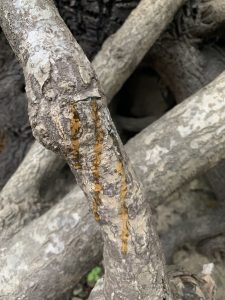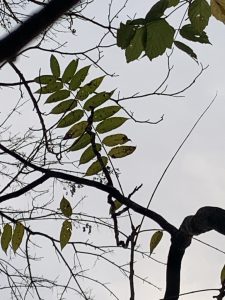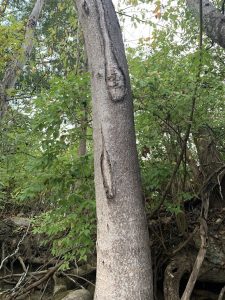10/13/19, 6:11 PM
If you’ve been keeping up with my blog posts, you’re probably aware of the mystery tree root I’ve been sitting on. I’ve mentioned my needing to identify it (at least I think I have), and well, this blog assignment was the perfect opportunity for me to do it! It was quite tricky, as I’ve come to learn that arboreal identification is absolutely not my cup of tea. However, apparently it is Professor Wilson’s cup of tea (or any other hot beverage of choice), and he helped me identify it as a green ash tree (Fraxinus pennsylvanica). This blog post was a rather nice change of pace; I enjoyed focusing on only one organism, rather than all of them at once as we have in the past two sit-spot blogs.
The temperature was cooler than it was in my past two visits, thankfully, and the sky was slightly cloudy. The water of the creek was not as cold as I expected (again, thankfully), and all and all, the day was quite nice for a tromp about in the creek.
The first thing I noticed about the green ash tree, was that there were a few streams of sap leaking from a small divot in the wood (see picture below). This had not been there before (or at least I haven’t noticed it before…), and after doing some research, I found that it’s an adaptation of trees to stave off freezing in the winter! Very cool. Unfortunately, this didn’t help in the identification process, as a great number of trees have sap
I knew, of course, that leaves are very important in identifying trees, because they tend to vary between species. However, now that autumn is finally settling in, the ash was nearly barren of any leaves. I managed to get a few grainy photos of some that were high up, though. (See below). A few leaves are green, but most had turned a bright yellow, a shade that is reminiscent of the hue of a buttercup or dandelion. They were sort of football-shaped, for lack of a better word, and opposite each other. The bark is a pale brown gray (like the color of ash), and smoother than most other barks.
These two traits – the leaves and the bark – were what hinted at it being an ash tree. To figure this out, I followed a dichotomous key I found online about tree species native to Virginia. This led me to the conclusion that it was an ash tree, but to make sure I asked Professor Wilson as well.
After finding this out, I was able to find more information about this tree. It’s quite common and widespread (the most widespread ash tree) in North America, spanning almost the entire continent easy of the Rocky Mountains. It’s a fast-growing tree that, once it is established, can withstand climactic extremes. Unfortunately, it is susceptible to a wide variety of pests – one of which you’ve probably already heard about: the emerald ash borer. These beetles bore into the wood at the center of the tree, which causes dieback, weakness, and death. In fact, the ash borer has caused a significant loss of white ash trees, and the industries that have used the wood of white ash in their products have begun using green ash instead. Green ash is used to make tool handles, baseball bats, canoe paddles, and guitars.





That’s so cool that your tree is an Ash tree! Did it seem healthy?
The sap adaptation is really cool! I believe I have a few of these trees near my sit spot as well.
I like that adaption! I never knew that and it seems like something people should commonly know. I also really liked your picture of the leaves, it has a very nice aesthetic.